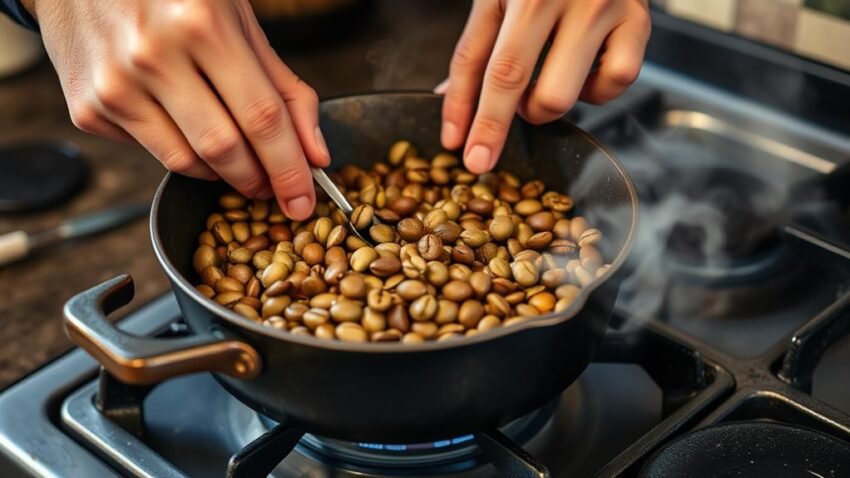Roasting coffee beans at home involves a few key steps and equipment choices. First, select your roasting method, such as using an oven, popcorn popper, or a home coffee roaster. Heat the green beans, listening for the first and second "cracks" to gauge roast levels. Proper temperature control and timing are essential. Once roasted to your preferred level, cool the beans rapidly using a cooling tray or fan. Store them in airtight containers to maintain freshness. Experimenting with different beans and methods can further personalize your coffee roasting experience. To master this process, let's explore more details on techniques and tips.
Methods of Home Coffee Roasting
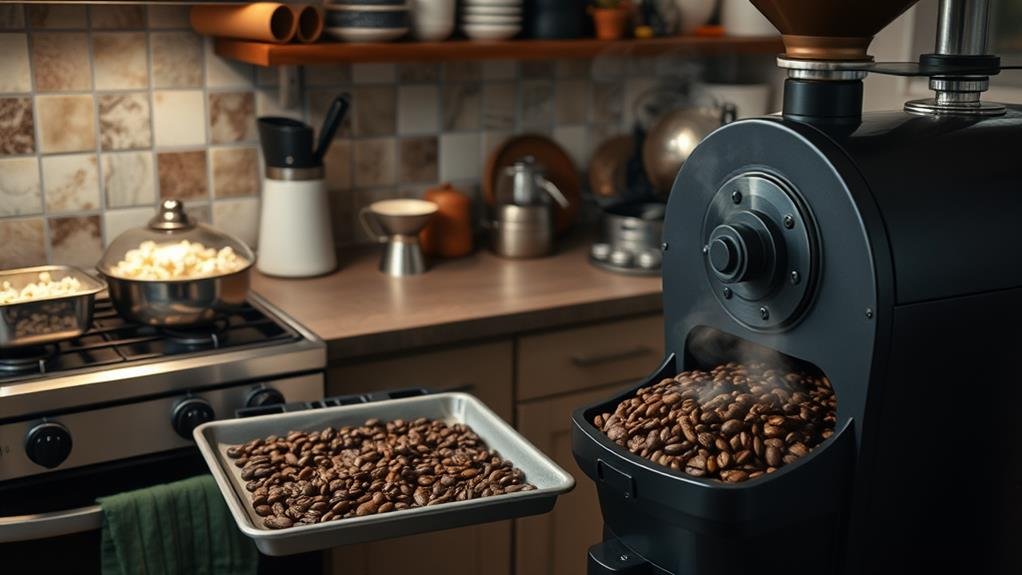
When it comes to roasting coffee beans at home, there are several methods you can try, each offering its own set of advantages and challenges. One of the simplest methods involves using your oven. By spreading green coffee beans on a baking sheet and roasting them at a high temperature, you can achieve a decent roast. However, this approach may result in uneven roast levels.
For those looking for a bit more control, a popcorn machine can be an effective tool. This method allows for better airflow and more consistent heating, leading to more uniform flavor profiles. However, close monitoring of the process is crucial to avoid overheating.
Drum roasters are another popular option for home enthusiasts. These machines offer excellent control over the roast by rotating the beans consistently. Drum roasters tend to be more expensive but are preferred for their ability to produce professional-quality results.
Each roasting method impacts the flavor profile of the coffee, so experimenting with different techniques will help you find your desired roast. Whether you use an oven, a popcorn machine, or a drum roaster, understanding these methods will enhance your home coffee roasting experience.
Basic Coffee Roasting Process
Choosing the right method for roasting coffee at home lays the groundwork, but understanding the basic coffee roasting process itself is where the magic happens. Roasting coffee beans involves transforming green coffee into brown, aromatic roasted coffee using heat. Although the roast time can vary depending on your roasting machine and batch size, it typically lasts around 10 minutes for smaller batches and up to 16 minutes for larger ones.
During the roasting process, you'll notice an audible crack, which signals different stages of roasting. The first crack indicates the beans have reached a light roast level, while the second crack points to a medium to dark roast. The key to mastering home roasting lies in controlling the temperature and timing to achieve the desired roast level.
Here's a simple breakdown:
| Stage | Description |
|---|---|
| Green Beans | Raw, unroasted coffee beans |
| Yellowing | Beans begin to turn yellow |
| First Crack | Audible crack, beans expand |
| Desired Roast | Monitor for light, medium, or dark roast |
Choosing a Roasting Method
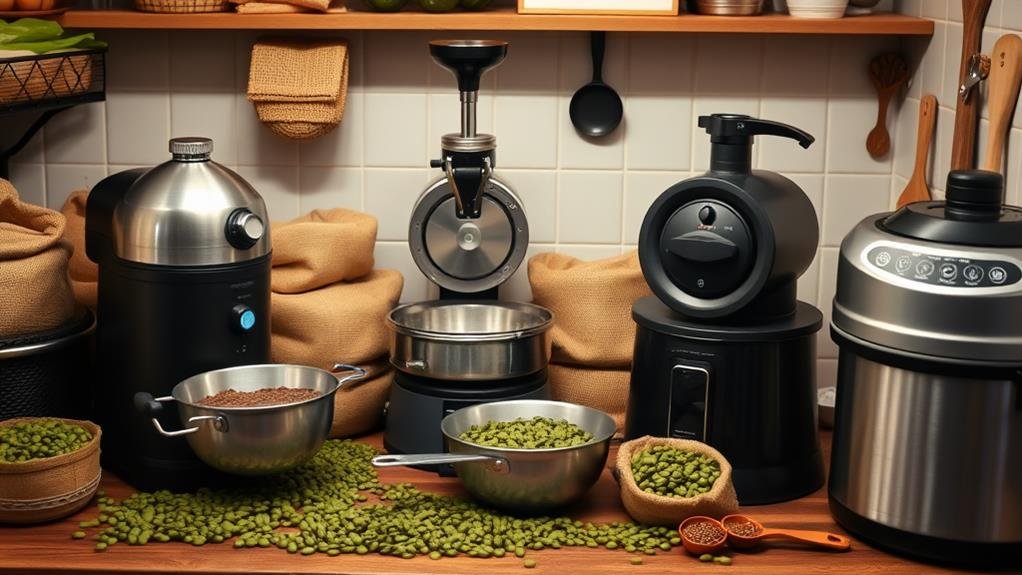
As you embark on the journey of roasting coffee at home, selecting a method that aligns with your budget and batch size is vital. Affordable options like the stovetop, oven, or a popcorn popper are excellent for beginners. These methods require minimal investment and can produce decent results if you're attentive. A stovetop or oven allows you to roast larger quantities but demands constant monitoring to ensure even roasting.
For more consistent and even roasts, electric popcorn poppers are a step up. They provide better airflow and heat distribution, which is essential for uniform roasting coffee beans. If you're looking for more precision, home coffee roasting appliances might be the way to go. These devices often feature timers and temperature controls, making it easier to achieve the perfect roast.
When considering batch size, air roasters are suitable for smaller amounts, offering good control and quick roasting times. On the other hand, drum roasters are ideal for larger quantities and typically provide a more even roast. Ultimately, your choice will depend on how much coffee you plan to roast and your budget for equipment.
Home Coffee Roasting Appliances
Diving into the world of home coffee roasting appliances opens up a domain of possibilities for achieving that perfect roast. When considering home coffee roasting, choosing the right appliance is essential for a smooth roasting process. Air roasters and drum roasters are the two primary types of coffee roasting appliances you'll encounter.
Air roasters are typically smaller, making them ideal for those who prefer to roast smaller batches. They often come with features like chaff collection and smoke reduction, which can simplify the roasting process and keep your kitchen cleaner. On the other hand, drum roasters can handle larger batches and offer more robust control over roasting, including timers and temperature adjustments.
There isn't a one-size-fits-all best roaster; your decision will depend on factors like batch size, desired features, and available space. Investing in a home coffee roasting appliance can elevate your home roasting experience by providing greater consistency and control compared to DIY methods. Different roasting methods and appliances cater to varying roasting preferences, allowing you to customize your coffee to your exact taste. So, whether you opt for an air roaster or a drum roaster, you're bound to enhance your coffee roasting journey.
Selecting Green Coffee Beans
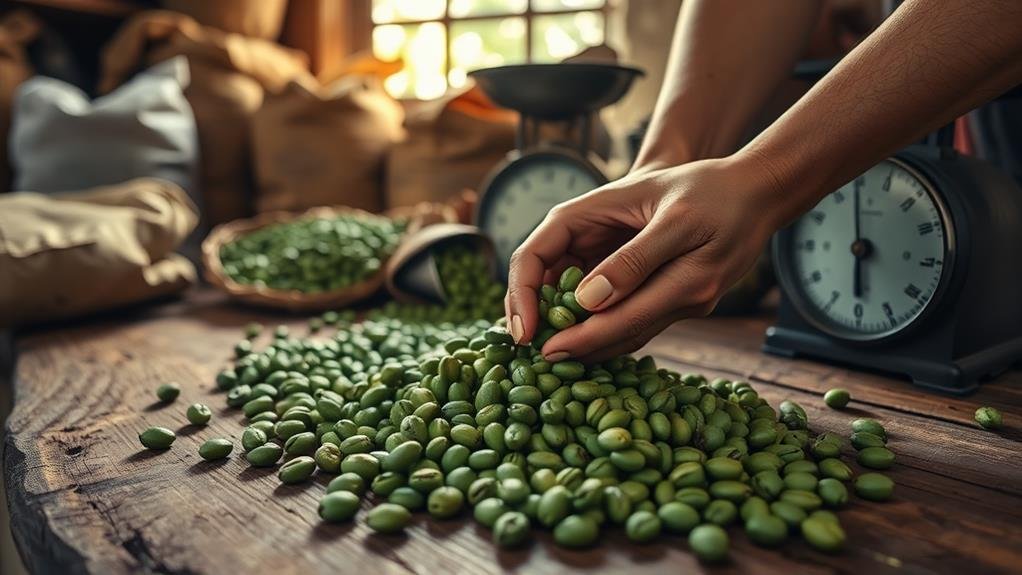
Having the right appliance sets the stage, but the journey to exceptional coffee truly begins with selecting the best green coffee beans. These beans are the seeds found inside coffee cherries, and they come in two main types: Arabica beans and Robusta beans. Arabica beans, which make up 60% of global production, are known for their delicate flavors and are often preferred in specialty coffee. On the other hand, Robusta beans offer a stronger, more bitter taste and contain higher caffeine levels compared to Arabica.
When selecting beans for your roasting journey, consider trying a variety of green coffees from different regions. Sweet Maria's Sample Set is an excellent way to familiarize yourself with various origin characteristics. This knowledge will help you better understand how different beans react to your chosen roasting method.
For further guidance, the Green Coffee FAQ is a valuable resource that provides detailed information on different types of beans and their unique characteristics. Understanding these aspects will help you make informed decisions and achieve the best possible results when you roast coffee beans. So, take your time exploring and selecting the green coffee beans that will elevate your coffee experience.
Roast Levels
When it comes to roasting coffee beans, understanding roast levels is essential for achieving your desired flavor profile. The roast levels range from light to dark, each affecting the flavor and aroma of your coffee in unique ways.
A light roast is achieved with a shorter roasting time and lower roasting temperature. This level preserves more of the bean's original characteristics, resulting in a coffee with higher acidic notes and a more delicate flavor profile. If you prefer a coffee that highlights the natural qualities of the beans, a light roast is your best bet.
On the other end of the spectrum, a dark roast involves a longer roasting time and higher temperatures. This process diminishes the bean's original characteristics but produces a bold flavor with notably reduced acidity. For those who enjoy a stronger, more robust cup of coffee, a dark roast is ideal.
The French Roast is the darkest roast level, characterized by a smoky, charred taste. This level pushes the roasting to its limits, creating a coffee that is intensely bold and full-bodied.
Understanding these roast levels helps you tailor your roasting process to achieve the perfect balance of flavor and aroma for your taste preferences.
Bean Cooling and Storage
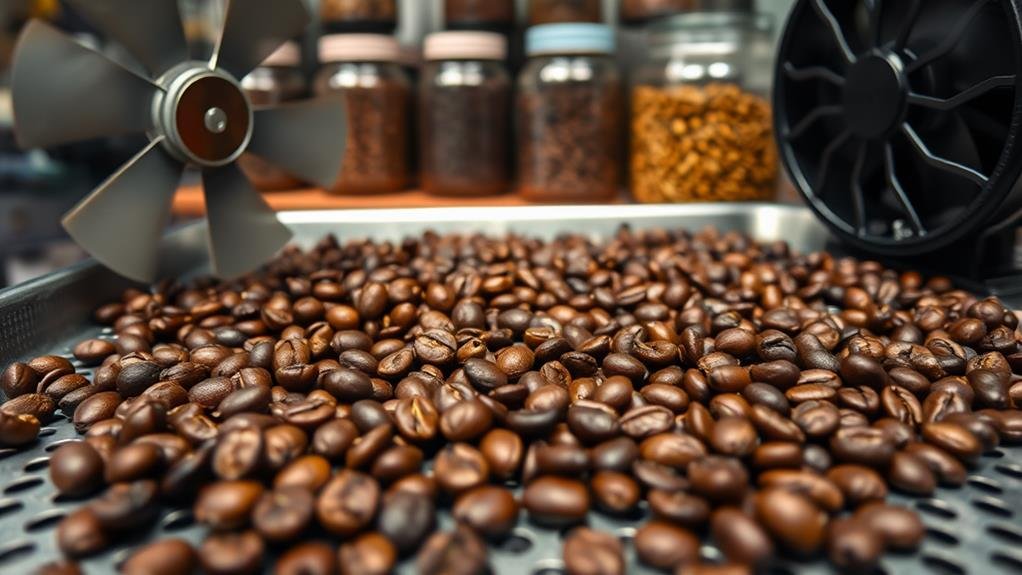
After achieving your desired roast level, it's essential to cool your coffee beans quickly to halt the roasting process and lock in those carefully developed flavors. Cooling roasted beans swiftly guarantees they don't over-roast due to residual heat.
There are several effective bean cooling methods. You can use a cooling tray, colander, baking sheet, cooling rack, or even a fan. Using a fan can speed up the bean cooling process, ensuring your roasted coffee beans retain their best flavors.
Here's a quick comparison of cooling methods and storage options:
| Cooling Method | Advantages | Disadvantages |
|---|---|---|
| Cooling Tray | Even cooling, user-friendly | Requires specific equipment |
| Colander | Convenient, utilizes airflow | May cool unevenly |
| Baking Sheet | Easy to spread beans | Slower cooling |
| Cooling Rack | Good airflow | May require multiple racks |
| Fan | Rapid cooling | May scatter beans |
Once your beans are cooled, proper storage is necessary. Store your roasted coffee beans in airtight containers, valve-sealed bags, or mason jars to protect them from air, light, and moisture. You can also use ceramic canisters or even freeze the beans to maintain freshness throughout your roasting journey.
Conclusion
So, now you know how to roast coffee beans at home. It's quite the journey from green beans to that perfect roast, isn't it? You'll experiment with different methods, appliances, and roast levels, all while perfecting your technique. Ironically, after all this effort, you'll realize that the perfect cup is just a matter of personal taste. But hey, at least you'll enjoy the process and, hopefully, savor the results. Happy roasting!

